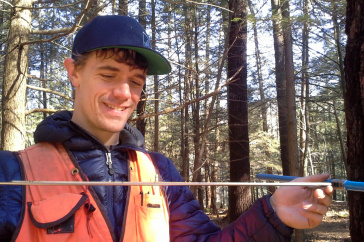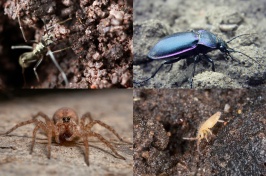The University of New Hampshire is a flagship research university that inspires innovation and transforms lives in our state, nation and world. More than 16,000 students from all 50 states and 71 countries engage with an award-winning faculty in top ranked programs in business, engineering, law, health and human services, liberal arts and the sciences across more than 200 programs of study. UNH’s research portfolio includes partnerships with NASA, NOAA, NSF and NIH, receiving more than $100 million in competitive external funding every year to further explore and define the frontiers of land, sea and space.
UNH Research Finds White Pine Needle Damage Hampers Health of Region’s Trees

Cameron McIntire, a doctoral student in natural resources and the environment at UNH, cores an eastern white pine to assess the impact of White Pine Needle Damage. Credit: Isabel Munck, U.S. Forest Service
DURHAM, N.H. – White pine needle damage, a complex of foliar diseases that is being accelerated by the region’s warmer, wetter springs, is slowing the growth and hampering the health of the region’s eastern white pines, according to new research from the University of New Hampshire.
“This new disease impacts one of New Hampshire’s most widespread and economically important tree species,” said Heidi Asbjornsen, associate professor of natural resources and the environment. “Eastern white pine composes more than 500,000 acres of New Hampshire forest land. Of the estimated 30 billion board feet of saw timber, 31 percent is white pine.”
“Additionally, white pine has many important ecological roles in New Hampshire’s forests, including providing a food and habitat for numerous wildlife species. Its seeds are eaten by various birds and small mammals, while rabbits and deer browse white pine foliage. White pine forests support diverse wildlife communities, including breeding birds, bald eagles, and cavity-nesting wildlife,” said Cameron McIntire, a doctoral student in natural resources and the environment who also is working on the project.
Infected trees experience a yellowing of mature needles in the early spring, followed by a large defoliation event beginning in mid-June.
“This disease is of great concern because it consists of native fungi that are behaving in new ways. Prior to 2010, white pine needle damage fungi were not considered a significant forest health issue. However, recent changes in the regional climate, namely a trend of warmer and wetter springs, have facilitated the spread and severity of this disease complex,” Asbjornsen said.
As a result, researchers with the NH Agricultural Experiment Station are assessing the impacts of the disease on tree health and productivity, and developing guidelines for land managers for mitigating the negative impacts of the disease.
Scientists have been able to directly measure the defoliation caused by white pine needle damage using litterfall methods that are commonly used to estimate above ground biomass production.
“We found that 47 percent of the total annual litterfall is now occurring during the months of June and July, much earlier than the time of natural needle senescence in October. Typically, white pine will cast the majority of its mature second and third-year foliage in the month of October, just as broadleaf species like oak and maple,” McIntire said.
“As a result of white pine needle damage, much of the mature foliage is lost during the most productive part of the growing season, so trees are not able to assimilate as much carbon as would be expected within healthy stands. Furthermore, the new needles take approximately four months to fully develop, during which time they do not photosynthesize at the same rate as mature needles. This is quite different from broadleaf species, which flush out new foliage in a matter of days in the early spring and can often re-flush foliage if a defoliation event occurs,” he said.
In addition, researchers found that infected trees are not able to resorb nitrogen from needles cast during summer. This is important because nitrogen is an essential element in the enzymes that facilitate photosynthesis.
Understanding the impacts of this disease is the first step toward developing management guidelines. For example, eastern white pine is known to respond well to thinning treatments. With this in mind, researchers reduced stem densities within infected stands. They found that tree vigor increased in the second year following the treatments, and disease severity was reduced. Based on these promising results, they now recommend that landowners prioritize thinning within infected stands or stands that are at high risk of infection.
This research will be presented in a forthcoming special issue of the journal Forest Ecology and Management about eastern white pine.
This material is based upon work supported by the NH Agricultural Experiment Station, through joint funding of the National Institute of Food and Agriculture, U.S. Department of Agriculture, under award number 1013351, and the state of New Hampshire. This work also has been funded by the USDA Forest Service via a Forest Health Monitoring grant.
Founded in 1887, the NH Agricultural Experiment Station at the UNH College of Life Sciences and Agriculture is UNH’s original research center and an elemental component of New Hampshire's land-grant university heritage and mission.
PHOTOS AVAILABLE FOR DOWNLOAD
https://colsa.unh.edu/nhaes/sites/colsa.unh.edu.nhaes/files/media/images/cameronmcitnire.jpg
Cameron McIntire, a doctoral student in natural resources and the environment at UNH, cores an eastern white pine to assess the impact of White Pine Needle Damage. Credit: Isabel Munck, U.S. Forest Service
https://colsa.unh.edu/nhaes/sites/colsa.unh.edu.nhaes/files/media/images/diseasedtree.jpg
Starting around 2010, eastern white pine began being impacted in the region by a collection of foliar pathogens termed White Pine Needle Damage. Infected trees experience a yellowing of mature needles in the early spring, followed by a large defoliation event beginning in mid-June. Credit: Isabel Munck, U.S. Forest Service
https://colsa.unh.edu/nhaes/sites/colsa.unh.edu.nhaes/files/media/images/treeremoval.jpg
Experiment station researchers recommend that landowners prioritize thinning within infected stands or stands that are at high risk of infection, following established stocking guidelines for eastern white pine. Credit: Sophie Wilderotter, USDA ARS
-
Media Contact
Lori Tyler Gula, PhD | NH Agricultural Experiment Station | lori.gula@unh.edu | 603-862-1452
Latest News
-
April 15, 2025
-
Research Finds Rural Americans Carry Heavy Burden Accessing Social Security Benefits and InformationMarch 27, 2025
-
March 25, 2025
-
March 17, 2025
-
March 12, 2025














































